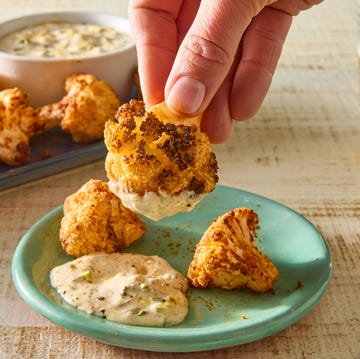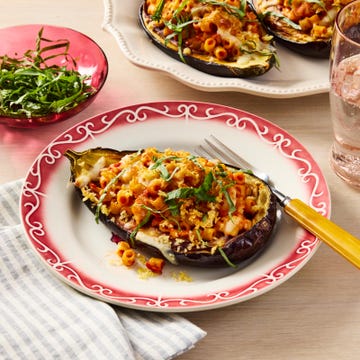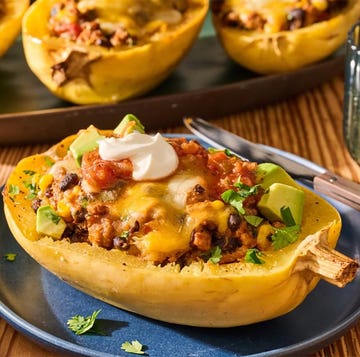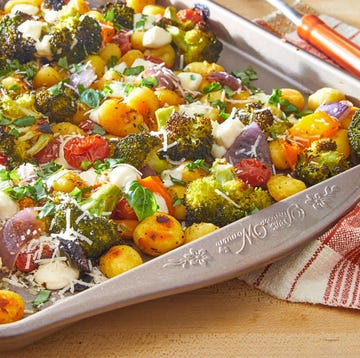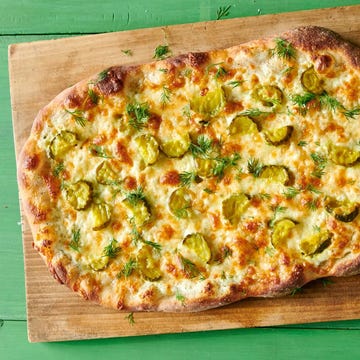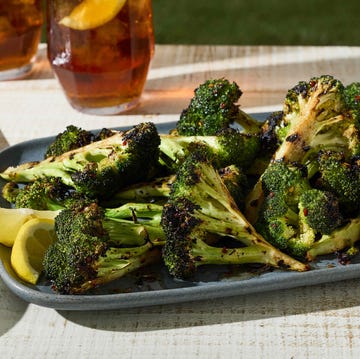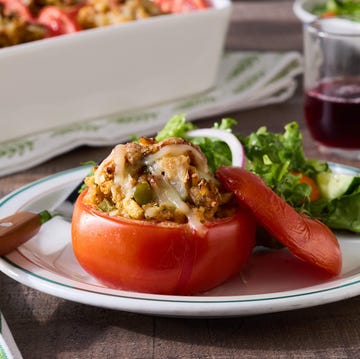1Broccoli
 enrouteksm//Getty Images
enrouteksm//Getty ImagesBroccoli is a garden favorite that keeps on giving—even after you harvest the main head, smaller side shoots will keep growing! Plant in early spring or late summer for the best results, and make sure it gets plenty of sun and nutrient-rich soil. If the weather heats up too fast, broccoli might bolt (aka flower), so keep an eye out and harvest before the buds start to open. Want the best flavor? Pick in the morning when heads are firm and packed with nutrients!
When to plant: Start seeds indoors early to mid-spring for spring plantings and start seeds indoors or out in early to late July for fall.
SHOP NOW
2Potatoes
 Peter Dazeley//Getty Images
Peter Dazeley//Getty ImagesThere’s nothing like homegrown potatoes, and the best part is, they’re super low-maintenance! Plant seed potatoes in loose, well-draining soil, and keep hilling up the dirt as they grow to protect them from sunlight. Once the leaves start to yellow, it’s harvest time—dig carefully so you don’t bruise your spuds. Bonus: Store them in a cool, dark place, and they’ll last for months!
When to plant: Mid March through early May, depending on your location.
SHOP NOW
Advertisement - Continue Reading Below
3Onions
 Cavan Images//Getty Images
Cavan Images//Getty ImagesOnions are the ultimate set-it-and-forget-it crop—just plant, water, and wait. Whether you start with seeds, sets, or transplants, make sure they have plenty of sun and loose soil to grow nice and big. The trick to sweeter onions? Keep them well-watered, especially as the bulbs start to form. When the tops flop over, they’re ready to pull, cure, and store!
When to plant: Late March to early April, when the temperatures won't dip below 28°F.
SHOP NOW
4Okra
 wulingyun//Getty Images
wulingyun//Getty ImagesOkra loves the heat, so if your summers are sweltering, this is your plant! Sow seeds directly in warm soil, and once it takes off, you’ll be harvesting pods almost daily. The key is to pick them young—wait too long, and they’ll turn tough and fibrous. Pro tip: Wear gloves when harvesting if you’re sensitive to the tiny spines on some varieties!
When to plant: Late April or early May in southern climates for a summer crop or early August for a fall harvest. June is best for northern climates.
SHOP NOW
Advertisement - Continue Reading Below
5Turnips
 PeopleImages//Getty Images
PeopleImages//Getty ImagesFast-growing and packed with flavor, turnips are a double-duty crop—you can eat both the greens and the roots! Sow seeds in early spring or fall, and harvest while they’re still small for the best taste. The greens add a peppery kick to salads, while the roots can be roasted, mashed, or eaten raw. No need to wait too long—these little guys are ready in just a few weeks!
When to plant: A few weeks before the predicted last spring frost date for late spring harvest, late summer for a fall harvest, or early fall for a late fall harvest.
SHOP NOW
6Bok Choy
 Gunawan Prasetyo//Getty Images
Gunawan Prasetyo//Getty ImagesIncreasingly popular in recipes and grocery stores, this Asian cabbage can be propagated from leftover scraps and be ready to harvest within a month. It also grows fast from seeds in full sun in about 45 days.
When to plant: Early spring for a late spring harvest or late summer through early fall for a late fall harvest.
SHOP NOW
Advertisement - Continue Reading Below
7Radishes
 Ralf Geithe//Getty Images
Ralf Geithe//Getty ImagesThese hardy root vegetables are a great last-minute crop—they can be ready for harvest as soon as three weeks after planting! While they're known for their colorful roots, the entire plant is actually edible.
When to plant: Early April through early May for a spring harvest and early August through early September for a fall harvest.
SHOP NOW
8Pumpkins
 Khanh Bui//Getty Images
Khanh Bui//Getty ImagesIf you're debating whether to grow pumpkins in your garden, we have just two words for you: pumpkin pie. You'll need a lot of space and a long growing season for this winter squash but we like to say, if you've got it, plant it!
When to plant: Well after danger of frost is past and the soil is between 65° and 95°F.
SHOP NOW
Advertisement - Continue Reading Below
9Cabbage
 undefined undefined//Getty Images
undefined undefined//Getty ImagesThis hardy, leafy vegetable thrives with 6 to 8 hours of direct sunlight per day so be sure to save a sunny spot in your garden if you plan to grow cabbage. Start sowing your seeds indoors for a summer harvest.
When to plant: About 6 to 8 weeks before the last spring frost for a summer harvest.
SHOP NOW
10Carrots
 Bill Sykes//Getty Images
Bill Sykes//Getty ImagesDid you know carrots taste even sweeter when they're fresh from the garden? That's just one of the many reasons to start growing this colorful root vegetable at home. Carrots can be a tricky plant, but if you use mulch and remember to keep the soil well-watered during hot spells, you should have lots of luck!
When to plant: About 2 to 3 weeks before the last spring frost date.
SHOP NOW
Advertisement - Continue Reading Below
11Beets
 Victoria Pearson//Getty Images
Victoria Pearson//Getty ImagesThis colorful root vegetable is super easy to grow from seed. Beets are a great cool-weather crop because they can endure frost and near-freezing temperatures.
When to plant: Start in early spring and make successive plantings every 2 to 3 weeks until mid-summer.
SHOP NOW
12Lettuce
 Natasha K//Getty Images
Natasha K//Getty ImagesGourmet greens often get icky fast in the fridge. Instead of picking them up at the store, plant your own and you can harvest some leaves right before dinner. Lettuce likes cool weather and grows well when planted as seeds. It’s also a great choice for planting in pots and window boxes because the roots are shallow. Keep the plant moist as the seeds sprout, then harvest when leaves are a few inches long. If you like variety, choose a mesclun mix which includes several different types of lettuce in one seed packet.
When to plant: Early spring or late summer for a fall harvest.
SHOP NOW
Advertisement - Continue Reading Below
13Tomatoes
 P A Thompson//Getty Images
P A Thompson//Getty ImagesYou can grow heat-loving tomatoes from seed, or if you prefer, you can choose transplants, which you’ll find at local nurseries or online. Pay attention to what type you’re buying: Indeterminate types keep growing and producing until a frost, so their sprawling vines need to be staked—this means they’re not great in containers because they get top-heavy. Determinate types have fruit that ripens in a short period of time—they'll stay about three to four feet tall. Cherry tomatoes are best for beginners, and many new varieties stay nice and compact so they’re ideal for planting in containers.
When to plant: After all danger of frost is past.
SHOP NOW
14Beans
 John Block//Getty Images
John Block//Getty ImagesBeans come in tons of varieties, and they’re prolific (plus, the more you pick, the more they produce!). Sow seeds directly in the ground because transplants don’t usually do well. Look for pole beans, which need plenty of space and a trellis to climb, or bush beans, which grow in a more compact form, so they'll work in containers. Read the seed label to find “days to maturity” so you know when to harvest specific types—you don’t want to wait too long because they’ll get tough.
When to plant: After the last frost.
SHOP NOW
Advertisement - Continue Reading Below
15Peppers
 Geri Lavrov//Getty Images
Geri Lavrov//Getty ImagesPeppers love the heat, and they grow well in beds, containers, or on sunny patios and decks. Transplants are a better choice unless you have time to start them indoors about six to eight weeks before the last frost. Most peppers need staking, so make sure you have enough space.
When to plant: After the last frost.
SHOP NOW
16Herbs
 Flowerphotos//Getty Images
Flowerphotos//Getty ImagesEven if you only have a tiny balcony, you can still grow fresh herbs! It’s so much fun to snip off a few leaves for every meal, and it’s much cheaper than buying those pricey packages at the store. Herbs grow equally well in containers or beds. You can grow most from seed, but if you’re in a hurry, they’re not super-expensive to purchase as transplants. Better yet, some herbs, such as chives, sage, and thyme, are perennial and will return next spring.
When to plant: Mid-spring.
SHOP NOW
Advertisement - Continue Reading Below
17Cucumbers
 Vostok//Getty Images
Vostok//Getty ImagesMost cucumber types are heat-loving vines, so you'll need some space to grow them. You also can provide a cage or trellis for them to climb vertically, which will take up less room in your garden. Look for round, yellow, miniature, or compact varieties. It’s best to plant seeds directly in the ground as transplants can be fussy.
When to plant: After all danger of frost is past.
SHOP NOW
18Swiss Chard
 mgturner//Getty Images
mgturner//Getty ImagesThis beautiful green has long, elegant leaves with brightly-colored ribs of red, yellow, orange, or white. Swiss chard is not only delicious—it looks beautiful! It grows well from seed, so you can plant it directly in your garden. In hot climates, if you give it some afternoon shade, it will produce all the way until the first frost. In the rest of the country, you can pick the outer leaves and it will keep producing throughout the season.
When to plant: Mid-spring.
SHOP NOW
Advertisement - Continue Reading Below
19Kale
 Jacky Parker Photography//Getty Images
Jacky Parker Photography//Getty ImagesThis super-food is incredibly hardy and doesn’t mind the cold one bit. In fact, many types will survive the winter and green up again in the spring. Kale does best in beds, and seeds or transplants are fine (though seeds are cheaper). If you’re tight on space, however, you can plant it in containers and harvest it as baby kale when it’s young and tender.
When to plant: Mid-spring or late summer for a fall harvest.
SHOP NOW
20Summer Squash
 mikroman6//Getty Images
mikroman6//Getty ImagesMost squash are super easy to grow—you'll probably end up with tons to share with friends and family! Summer squash comes in a variety of sizes and types, but they mostly grow on vines that need room to spread. They do well when planted from seed or as transplants (though young plants don’t like their roots disturbed when planting, so be careful when setting them out). Bear in mind that these veggies love heat! Pick them before they get gigantic or they’ll become too seedy.
When to plant: After all danger of frost is past.
SHOP NOW

Arricca Elin SanSone is a writer, editor, and content creator who specializes in lifestyle and gardening. With a background in health reporting, she applies these same research skills when writing about the science of growing things. She trials new plants in her expansive garden, and her houseplant collection consists of 60+ varieties. Arricca has written thousands of articles for publications such as Country Living, House Beautiful, Good Housekeeping, Prevention, VERANDA, Southern Living, and more. She’s happiest when digging in the dirt, baking, or spending time with the people and dogs she loves.
Advertisement - Continue Reading Below
Advertisement - Continue Reading Below
Advertisement - Continue Reading Below




